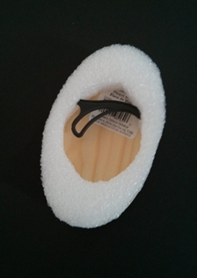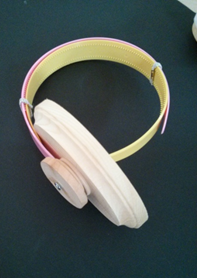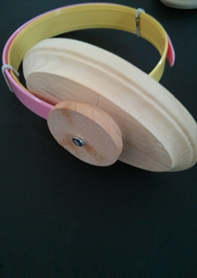Over-Ear Headphone Redesign
A redesign of traditional over-ear headphones for improved ergonomics and comfort.
Context
In our Grade 12 Advanced Placement Chemistry class, we were given a very broad final task called the “Design, Thinking, and Communication” (DTC) project. The premise was simple: make something better. Anything.
This project was set up in such a way that it would allow us, in our self-determined groups, to deal with any field of our own choice, so long as we properly documented, in detail, the entirety of our project. This was to be done entirely on our own time, as zero time was provided during school hours for us to work on our project.
Planning
As with every project, preliminary planning was everything. We spent most of our time drawing and redrawing, imagining and re-imagining, designing and redesigning our concepts. Countless brainstorming sessions were spent in the cafeteria after school, at each other’s houses, and at the local library.
Process
When thinking of things to improve, we quickly turned to ourselves in search of frustrating problems that we encountered in our daily lives that we felt should no longer exist.
The Stylus Mouse
This is one of my favourite designs and I really wish that we worked on this one. Our entire group had had previous experience using drawing tablets for computers before. We unanimously loved the stylus as a way to more naturally interact with our computers, but felt confined by the fact that it was necessary to use the slate part of the tablet in conjunction with the stylus, regardless of if we needed the pressure sensors at the time.
Thus the stylus mouse was born. We envisioned a stylus with an optical sensor that had a scroll slider and buttons built on to it. It would have allowed for the ergonomics of a pen with the functionality of a mouse. We were about to move forward with this idea when we decided that we would take a break and check out some projects on Kickstarter. And then we saw it. Literally an hour after we conceived our idea, someone else had posted their prototype for funding. After seeing this, decided that we would move on to try and produce something more original.
The Smart Calculator
Being students, the next concept we came up with was a better calculator. But not just a faster, more robust calculator, no. That simply would not cut it. We wanted to make a smart calculator. A calculator whose functionality was an all-in-one replacement for most, if not, all of the things that we currently carried in our pencil cases.
We drew some mock ups of some pretty crazy calculators. These designs ranged from having rulers as edges, to having a built in pencil sharpener and laser pointer combination. Our ideas ran wild, but we collectively decided against this idea. In hindsight, I am not entirely sure why we scrapped this idea. It would have been really cool.
The Back Brace
We then decided that we would try and do something to improve posture. Though we did not get very far with this idea, we did manage to flush out some of the details. We envisioned something that people would wear underneath their clothing that would allow them to sit comfortably on almost any surface. Not only would it be comfortable, but we envisioned an orthotics like solution that would also help to correct posture. We realized that this project would have been beyond our current scope of knowledge of the human body, and decided thus to think of a new idea.
The “Ultimate” Headphones
This was the idea that we moved forward with, and it is something that, to this day, I wish would be addressed by headphone manufacturers. Over-ear headphones, as comfortable as they are for your ears, are not nearly comfortable as they could be for your head. While more expensive headphones have increased ergonomic options, none came close to the level of ergonomic, user-controllable micro-adjustments that we envisioned.
Being avid users of over-ear headphones, we found that it was near impossible to find a “perfect” set of headphones. While over-ear headphones provide a superior immersive experience because of their large drivers and improved noise isolation abilities, these qualities also cause headphones to be bulky and clunky. Moreover, the vast majority of headphones rely on a clamping mechanism to keep attached to the head, which, after extended periods of time, can cause mild discomfort to the user’s head. Thus our team sought to find a way to allow improve this user experience and to enable users to have more control over how they wear their headphones.
Process
Phase One: Research
After settling on redesigning headphones, we thought about the different ways that we could combat this issue of comfort (or rather lack thereof). It was clear that the next thing we would have to do is research.
A preliminary research session was held and during this meeting we investigated basic headphone ergonomics, current unique features of today’s top-tier headphones, and the overall consumer response to these products. This provided the necessary background to produce a survey that understands what wants and needs must be catered to for the average headphone user.
We then polled our friends as well as strangers through various social media outlets, gathering demographic data, as well as important information regarding their use case and their points of frustration with over-ear headphones. We also continued to scoured through various print and digital sources for information regarding common over-ear headphone usage, as well as friction points for current headphone users.
Based on our research, we came to the conclusion that headphone users saw three main areas of improvement for headphones: better distribution of applied pressure, more freedom to adjust the headphone band, and the ability to not use the band at all.
Phase Two: Prototyping and Iteration
With two of the three areas of improvement being based on the headphone band, it was clear that this was the area that we needed to focus on. After many rounds of brainstorming, we came up with the idea of taking the support mechanisms of athletic headphones and on-ear headphones, and creating a hybrid solution that would allow the user to place additional weight on the ears so as to reduce headband pressure.
This solution came in the form of user-insertable ear hooks that would be placed inside of the cup and clip around the user’s ear. These clips would allow for the ear to comfortably hold more weight. Using light weights, some creative thinking, and qualitative metrics, we found the maximum weight that the ear could carry comfortably for 2 hours, and used this as a design restraint for our prototypes.
We also decided at this stage that we wanted to make the headphone band rotatable for better ergonomics when combined with the ear hooks. Using 5 different pairs of headphones, we tested the feasibility of band rotation by rotating the headphones forwards and backwards to find the optimal range of rotation for the band that would not inhibit the user’s movement. We averaged our findings to come up with a reasonable design requirement.
From there, iterative design took its course. We continued to test various designs until we settled on a medium fidelity prototype.
Outcome



Unfortunately, I do not have many good pictures of this project to show. However, here are a few pictures of one of the earlier prototypes that we made. The band was able to rotate 135˚, as well as adjust in length. There was also a very preliminary version of our hybrid earhook mechanism as well.
One thing that I would like to highlight is the way the band is attached to the headphone unit. As illustrated by the second and third pictures, the band is attached to a round disk that is then attached to the ear cups, as opposed to the band being directly attached to the ear cups as found on most modern headphones. Our design isolated the headphone band as its own entity with its own axis of rotation that was separate from the ear cups. This allowed us to greatly increase the freedom of rotation of the band without introducing discomfort that users traditionally experience when their ear cups rotate in tandem with the headphone band.
Reflection
As part of this project, we also had to do a lot of in depth analysis as well, not only of our presented prototype, but of our future plans should we continue this project as well. This included rationalized decision making,risk analysis, marketing strategies, and expanded functionality for successive iterations (“version 2 planning”).
I wish that I had kept more of our initial rough work, as they were truly a sight to behold. This project was a very representative example of starting with an idea and developing it into a full-blown project. Not only did this project teach me the importance and value of proper research and documentation, but I also learned much about the iterative design process. I have already been able to apply the skills that I learned completing this project to other course work, and have even adapted some of our time allocation strategies to my daily routines.
We started off with such ambitious ideas, and from there we began to mold and remold our thoughts and plans until we arrived at our headphone idea. Had we not spend so much time in the planning and conceptual iteration phase, I do feel that our idea would have been a lot less refined and polished. Solid planning is often overlooked, especially in situations where time is limited. However, with efficient time management skills, we were able to properly conceptualize, prototype, and iterate upon something that I am genuinely proud of.